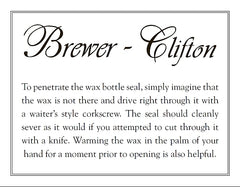A small number of wines around the world are bottled with a wax seal over the cork. Some beers, meads and spirits are sealed this way, as well. There are many ways this can be done. The most common is a small wax seal on top of the cork instead of a plastic or metal capsule. Some other wax seals are thin and cover the very top of the neck. Others are thick seals and cover all of the neck. The seal might be pure wax or a wax/plastic polymer. Dawnmist Chemicals says they use a blend but do not say what is in it – http://www.dawnmist.org/chemicals/winemaking/winewax.htm . Meanwhile, J Herbin says their sealing wax is made of wax, pine resin, ground limestone and lacquer – http://www.jherbin.com/sealing_wax_fabrication.shtml .
 Why Use A Wax Seal on Wine?
Why Use A Wax Seal on Wine?
The original purpose for wax seals was to create a more air tight seal than cork alone. Most of the wine supply stores today offer it as an option to add a touch of class to a winery’s packaging. Some restaurants choose not to carry these wines and some consumers do not buy them because of the hassle of trying to chip away the wax and clean up the table afterwards. There are several videos online and comments that advise to ignore the wax and simply turn the corkscrew worm straight through it. Others talk about the potential of the wax falling into the wine or the wine touching it when it is poured. The most reasonable discussions I have read about the topic are on the Dr. Vino blog – http://www.drvino.com/2009/08/13/vent-your-spleen-wax-seals-wine-cork-bottles/
Brewer-Clifton Winery uses thick wax seals on all of their wines and has instruction for dealing with them on their web site but not on the bottle label.
How To Open A Wax Sealed Bottle
 I advise servers and sommeliers to present the bottle and excuse yourself from the guest to step into the back of the house to remove the wax. My favorite method for removing the wax is to dip the neck of the bottle in hot water to soften the wax. Some kitchens have insta-hot water taps. If that is not available, the hot water spout from a coffee or espresso machine can be used. As long as you are only heating the neck of the bottle, the wine’s temperature should not be affected. Then the wax can either be cut or the corkscrew can be run through the top of the wax. Before pulling the cork all the way out the wax should be cleaned up to below the lip of the bottle. If this cannot be done cleanly a pour spout can be used so the wine does not touch the wax. Ideally the bottle should be presented to the guests again after the wax is removed and before the cork is removed, so removal can be done tableside. Another option that is much more rare and not appropriate in most restaurants is port tongs – see video. Whatever you do, advise the guests what you plan to do. Our video demonstration of this is coming to this space soon.
I advise servers and sommeliers to present the bottle and excuse yourself from the guest to step into the back of the house to remove the wax. My favorite method for removing the wax is to dip the neck of the bottle in hot water to soften the wax. Some kitchens have insta-hot water taps. If that is not available, the hot water spout from a coffee or espresso machine can be used. As long as you are only heating the neck of the bottle, the wine’s temperature should not be affected. Then the wax can either be cut or the corkscrew can be run through the top of the wax. Before pulling the cork all the way out the wax should be cleaned up to below the lip of the bottle. If this cannot be done cleanly a pour spout can be used so the wine does not touch the wax. Ideally the bottle should be presented to the guests again after the wax is removed and before the cork is removed, so removal can be done tableside. Another option that is much more rare and not appropriate in most restaurants is port tongs – see video. Whatever you do, advise the guests what you plan to do. Our video demonstration of this is coming to this space soon.
Have you struggled with a wax sealed bottle? Have you seen a mess made in restaurant service? Do you strongly like or dislike wax seals?
Take your wine service skills to the next level through our Wine Service Techniques.
Check out our full schedule of programs, workshops and public events. Private, customized experiences and corporate training is also available.

 Why Use A Wax Seal on Wine?
Why Use A Wax Seal on Wine?